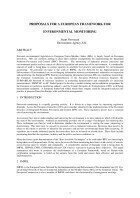Air Monitoring
PROPOSALS FOR A EUROPEAN FRAMEWORK FOR ENVIRONMENTAL MONITORING
Oct 06 2014
Author: Stuart Newstead on behalf of CEM
ABSTRACT
National environmental legislation in European Union Member States (MSs) is largely based on European Directives. MSs are currently putting in place their national arrangements for implementing the Integrated Pollution Prevention and Control (IPPC) Directive. The monitoring of industrial process emissions and environmental quality are key aspects of effective regulation and protection of the environment. A considerable amount of work is being done in various quarters to establish best practice and standards for environmental monitoring. Of particular relevance is the work of IMPEL: the EU Network for the Implementation and Enforcement of Environment Law on exchanging information between environmental authorities on inspection and monitoring; the European IPPC Bureau on exchanging information between MSs on compliance monitoring; the European Commission on the implementation of the European Pollutant Emission Register; the EUROAIRLAB Network of reference institutes in promoting harmonisation and comparable air emissions measurements; EMMTAP: an EC funded project to develop a model training and accreditation programme for the European air pollution monitoring industry; and the Comité Européen de Normalisation (CEN) in defining measurement standards. A European framework within which these outputs could be integrated and put into practice is proposed based on Europe-wide certification arrangements.
1 INTRODUCTION
Emissions monitoring is a rapidly growing activity. It is driven to a large extent by increasing regulatory demands. Across the European Union this will be given another stimulus by the implementation of the European Directive on Integrated Pollution Prevention and Control (IPPC) [1]. These regulatory drivers have a common aim of protecting the environment.
An essential first step to understanding and improving the environment is to have indicators which will describe the state of the environment. Ambient air monitoring provides one of a range of techniques for achieving this. These techniques can then be used to determine whether the environment is staying the same, improving or deteriorating. The latter may be caused by pressures such as industrial emissions. Decisions then need to be taken on the means to prevent or minimise the pressures and prevent environmental harm from occurring. If regulators are to make informed, quality decisions these have to be based on reliable facts. These facts include monitoring data that the regulators, industry and the public can have confidence in.
Many decisions, eg the determination of the “Best Available Techniques” to be used under IPPC are increasingly being taken on a European basis. If they are to be successful then monitoring data from a wide variety of sources across Europe must be reliable and comparable. A considerable amount of disparate work is being done by IMPEL, EIPPCB, EPER, EUROAIRLAB and CEN which is relevant to realising these objectives. This paper summarises this work. It proposes the establishment of a European Framework, based on Europe-wide certification arrangements, to build on the outputs from this work and ensure their effective and practical implementation.
Digital Edition
AET 28.2 April/May 2024
May 2024
Business News - Teledyne Marine expands with the acquisition of Valeport - Signal partners with gas analysis experts in Korea Air Monitoring - Continuous Fine Particulate Emission Monitor...
View all digital editions
Events
Jul 10 2024 Birmingham, UK
Jul 21 2024 Cape Town, South Africa
Australasian Waste & Recycling Expo
Jul 24 2024 Sydney, Australia
Jul 30 2024 Jakarta, Indonesia
China Energy Summit & Exhibition
Jul 31 2024 Beijing, China















